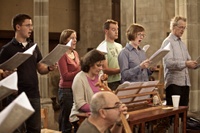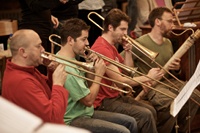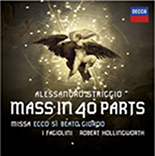Striggio Mass Choir IV: Matthew Venner, Kate Ashby, Catherine Pierron, Nicholas Hurndall Smith, Caroline Trevor, Simon ‘Simon’ Grant
Robert Hollingworth’s recording blog – September, 2010.
Sunday (rehearsal)
 Travel into London on the phone trying to fix a singer to replace Clare [Wilkinson] who is ill. Found someone who can do tomorrow at least – then we’ll have to see. One soprano also at 60% but on way up so fingers crossed.
Travel into London on the phone trying to fix a singer to replace Clare [Wilkinson] who is ill. Found someone who can do tomorrow at least – then we’ll have to see. One soprano also at 60% but on way up so fingers crossed.
Good session with smaller forces today: 4 viols, 4 wind and I Fagiolini’s core singers. Nice to remind ourselves of the madrigals we learnt at Dartington in the summer. What a really beautiful and perfectly produced voice Helen Neeves has.
One of the points of this recording is to focus on some of the unusual repertoire by Striggio that was written for intermedi (entractes) for wedding entertainments or political occasions. We tried his three-choir piece today written as to be sung by the three Medici towns of Siena, Florence and Rome. Lovely textures: viols, pluckers and wind.
Went to stay with John and Clare Gillies who were entertaining family. Talked about myself (yawn) only to discover (when the guests had gone) that they were Gerald Scarfe (iconic British cartoonist) and Jane Asher (actress). Felt rather small…
Monday (rehearsal)
8.30am The heating works in the church – Gott sei Dank. Two organs are delivered and tuned.
9.30am people start to arrive: 4 Rose Consort viols who open their instruments to acclimatise to the temperature and humidity; a few singers… Then all of a sudden everyone is here: 27 singers, 30 players, greetings, smiles, people who haven’t seen each other since that gig at you-know-where when that bloke died in the first half etc… Real sense of excitement: it’s so very rare for Renaissance groups to work on something in such numbers. A few of those here know the piece from the summer school version done at Dartington but for most, it’s a voyage of discovery.
Group into 5 ‘choirs’: strings / vocal+pluckers / brass / vocal / mixed wind+vocal. Me in middle. I’ve spent 10 months telling everyone about this project, enthusing, cajoling, desperately trying to raise the funds and all for the next five days. Here we go…
Oh my God.
It’s visceral.
It’s… it’s extremely well written! No messy first attempt at the multi-polychoral style, this, but very well-executed split-choir writing. There’s imagination, grandeur, colour – but very intimate writing at times. Being in the middle is amazing!
There are legends here: Sally Dunkley – stalwart of The Tallis Scholars for so many years and also the Sixteen, editor, and someone who knows and understands Renaissance vocal music from the inside as very few do. Cornettists Gawain Glenton, Dickie Thomas and Sam Goble playing so vocally and ornamenting too. The gutty sound of seven Renaissance viols and a Renaissance violin as well (Adrian Chandler of La Serenissima). Nick Smith and Matt Long doing great work on demanding virtuosic tenor parts. Bill Lyons and Sarah Humphrys bringing fantastic detail to the whole on their shawms, which are brilliant for a texture as big as this.
We work our way through nearly all of the mass and have a quick go at Spem even though I shall have extra people for that tomorrow (need more tenors). It’s a great sound but there’s lots to do. Lower brass need to be more vocal and work on the speech rhythms: I need a bit more sound from the viols although I see Alison Crum miming that if she saws any louder she’s likely to cut into the string… Above all, I need to develop a house style with the singers from outside regular Fagiolini, great names and experts in Renaissance polyphony though they are. Most important is the Italianate delivery of the vowel on the beat (not the consonant, which is more English), to open and brighten their vowels and to hear where the fifth is in this sixth comma meantone temperament.
Mr Decca turns up and he say ‘yay’. Which is good.
I’m confused as to how many Rebeccas are here. It’s five (including the camerawoman). Think I’ll call them all Bruce.
I’m like a boy in a sweetshop and absolutely loving it. There’s a great atmosphere, much helped by various funders who have come to listen and also brought cake. Renaissance musicians march (or possibly galliard) on their stomachs.
Tuesday (rehearsal)
 Clare still not well. Face it – she’s not going to make the recording which is a shame: I value her impeccable musicianship and smiley face. So Katy Hill will replace her but sing a different part – all a bit complicated really. I put her next to Billy [Purefoy] – someone’s got to be. Libby [Percival – I Fagiolini’s agent] here today and decides choir II [with Billy and Eamonn] is the naughty corner. Katy is perfect – clear, beautiful sound. What a depth of skilled singers of this repertoire there is in London.
Clare still not well. Face it – she’s not going to make the recording which is a shame: I value her impeccable musicianship and smiley face. So Katy Hill will replace her but sing a different part – all a bit complicated really. I put her next to Billy [Purefoy] – someone’s got to be. Libby [Percival – I Fagiolini’s agent] here today and decides choir II [with Billy and Eamonn] is the naughty corner. Katy is perfect – clear, beautiful sound. What a depth of skilled singers of this repertoire there is in London.
2pm The extras/replacements for Spem arrive including David Roblou to play the second organ. He’s a legend too. Made me truly understand continuo when I studied with him at Guildhall [school of music and drama]. Instantly makes his mark, adding texture and character in choir II of the Spem.
So off we go in this orchestrated version of Spem – 3 cornetts, 7 individual trombone parts plus the 8 strings. Part of the idea, discussed with Hugh Keyte at length in library corridors in recent months, is to assert the supremacy of parts 1 (sop) and 3 (tenor) in every 5-part choir because so much of the melodic dialogue is between them. Eamonn giving such line and drama to his choir which proves infectious. Everyone on top of their game, egging the others along. The focus is almost overpowering.
The fabulous A major chord on Respice (sounds nice in meantone and much more effective now that all the editorial C#s in the passage before have been taken out [more on this Historical Background]) almost shakes All Saints Tooting to its foundations: like a clean version of the overture to Rheingold.
I haven’t had much time to listen in the box [production room] but Adrian feels we’re getting there on the sound. It’s been great to have had him and Classic Sound here since Monday afternoon, gradually working on it. Difficulty is to get the detail while keeping the glory of the overall sound.
Email from one of the funders so overcome with the beauty of today that they make a further generous donation. Hooray and thank goodness there are people around who love this music with a passion: this project simply wouldn’t have happened otherwise. What a change from a few years back. I hope people actually buy this disc and don’t just ‘run off a copy for their friends’…
Wednesday (recording)
This is it. No excuses – work to the plan and keep everyone relaxed but focused. The tuning has been getting better but Richard Boothby (I think) suggests that we leave the organ playing fifths as people come in, to get them used to the fifths’ tempered colour. Why didn’t I think of that?
Lunchtime – we’re doing ok. Quite a bit in the bag and only minimal problems with noise from the school playground. The musicians are so fast that by Tuesday (second time through), everything was substantially better than the Monday: by now it’s really fizzing. So: urge people on to even more expressive performances (fight against the English disease of beautiful being enough) while keeping the discipline of the tuning, Italianate vowels and consonant placement. As the only singer in the string choir, Grace Davidson does perfect take after take of beautiful and perfect polyphony singing: something to remember. Alison Crum has brought a very good hat and sits there with her viol looking like an animated garden gnome, while every time that John Bryan plays a suspension, he smiles like a baby who’s just wet his nappy.
Sanctus
Can’t remember too much about the detail today but it buckets down with rain at the end as I go out to dinner with John and Clare to celebrate the birthday of their lovely South American lodger. Try not to worry about a) the noise rain would make on the church roof tomorrow b) what happens if the Heathrow flight path changes c) whether Clare will be well for Friday.
Thursday (recording)
 Simon Wall ill this morning – frantic calls to find another tenor for Spem. Benedict Hymas of Stile Antico is free (I love this town). Finish the mass with the 60-part Agnus Dei. For this, most players that have been doubling a voice are assigned their own part – but we still need an extra 11 people. So I’ve asked some singers I know from good amateur groups. This is less surprising if you understand the depth, quality and experience of the best amateur singers of Renaissance music in this country. Many have sung in top quality choirs while at university but then followed other careers.
Simon Wall ill this morning – frantic calls to find another tenor for Spem. Benedict Hymas of Stile Antico is free (I love this town). Finish the mass with the 60-part Agnus Dei. For this, most players that have been doubling a voice are assigned their own part – but we still need an extra 11 people. So I’ve asked some singers I know from good amateur groups. This is less surprising if you understand the depth, quality and experience of the best amateur singers of Renaissance music in this country. Many have sung in top quality choirs while at university but then followed other careers.
The entries of 60 genuine polyphonic parts, one after the other in a huge circle, with the different instrumental families adding changing colours as the piece progresses is hypnotic, but Striggio’s (by now) familiar harmonic patterns give it shape and direction. Then onto the rather different layout for his Ecce beatam lucem, the 40-part motet that’s been published for some 30 years but never recorded with instruments. To me the texture cries out for instrumental colour. I admire the Huelgas recording – it’s incredibly beautiful – but without the colour, grandeur and passion the text demands.
We’d have loved to record this on the five-storey cloud machine in Florence’s cathedral that Hugh Keyte believes the piece was written for, but the health and safety issues plus the thoughts of recorder players with vertigo and the nightmare of expensive instruments falling five storeys to smash on the heads of those below, bring me to my senses.
At lunch, it’s time to say goodbye to the Agnus extras and move on to Spem. A few tuning issues at the start but Emma Tring sounds so easy on her part – none of the grip often associated with that exposed entry. An interesting session for the instrumentalists as so few of them have played in this piece, protected as it usually is by its a capella halo [see sleeve note]. What is lovely is how the instrumental families (viols for choir I and II and brass for III and IV) give so much more colour to the exchange between the choirs. Trying hard to bring out the main soprano and tenor entries.
We get to 4.20 and Spem is finished. That’s it for the big pieces. Would love to crack open the champagne and celebrate but we have to get in the ‘Hercules and the monsters’ piece (what a name for a group – better than ‘I Fagiolini’ anyway) with 10 male singers and 10 brass/double reeds. Billy and Eamonn leading the way with tons of guts (Eamonn finishing the last chord with particular oomph). I think the monsters would be happy. How often do you get 2 cornetts, 4 sackbuts and 4 dulcians playing together? We go into overtime to record the Spem plainchant – a rather beautiful and relaxing end to the day. Lovely baritone bit in the middle with Berty Rice, Greg Skidmore and Eamonn. Little direction from me: these guys know what to do.
Going home to out of London tonight. Dealing with rush hour feels odd. I want to tell everyone what I’ve been doing all day but think better of it, remembering Hoffnung’s advice to foreigners visiting London (‘On entering an underground train, it is customary to shake hands with all the passengers.’)
Friday (recording)
Today is for the madrigals and intermedi pieces. All of a sudden, no hordes of people – feels more like a normal recording day. Start with Matt Long, four trombones and lirone. What a naturally beautiful voice. Encouraging him to work more with the text.
Moment of truth as Clare turns up: she has voice and will sing. This is good. Scary for her, though, as her solo piece (Fuggi spene mia – yes, the n is correct) is extremely fiddly: reams of semis and demi-semis. We have to create the effect (as described by Vasari) of off-stage trombones so they get sent 20 metres away which means a certain amount of anticipating. Clare is flashy and I have in my mind Vasari’s image of Psyche singing this surrounded by four ‘evils’ (The Rose Consort).
Two a capella pieces go ok and we’re on schedule. Clare at 80% stamina but never complaining: just gets on with it. The three-towns piece now: 1) viols + Helen Neeves 2) pluckers + Grace Davidson 3) wind with Clare. It’s perhaps a more subtle and indoors version of the piece than Grand Duke Cosimo might have imagined but ravishing. Adrian [Hunter – producer] is delighted. We then finish (in farewell symphony mode) with just two lutes and lirone, Dai [Miller] and Lynda [Sayce] noodling their way to divvies heaven [divisions = ornamentation] over Erin’s suave lirone sounds. Can’t quite believe that any of the takes are usable as Friday night in south London does its worst with a full siren choir but wonderful to watch the three of them doing their thing. No help needed from me.
And so we finish having reduced from 68 to 3 people.
What am I going to do for the rest of my life?
Buy your copy!
- I was thinking that. Also @JolyonMaugham was (which carries a little more weight). https://t.co/pAu9emYdGd
- For my birthday I have done admin, walked dog, and rehearsed Walton with @The24choir https://t.co/jNTU2B3UIw https://t.co/LDhso8U9jS
- It's very reasonably priced and all those benefits.... https://t.co/DFJS8e9Dqw


